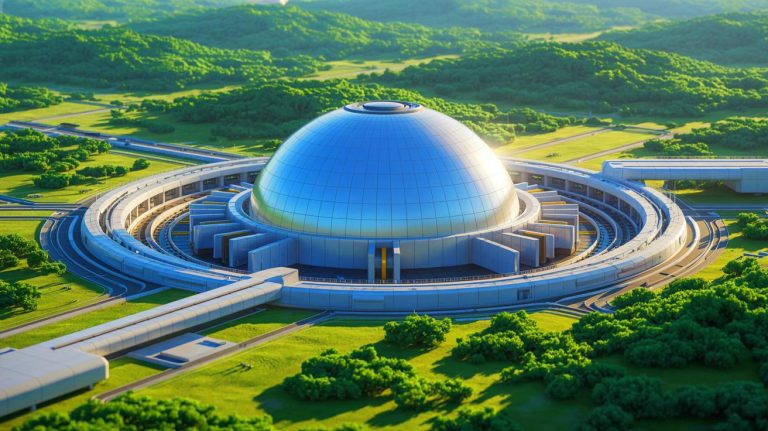| IN A NUTSHELL |
|
China’s recent unveiling of the CFR-1000 fast neutron reactor marks a pivotal moment in the evolution of nuclear energy technology. Promising to deliver up to 1.2 gigawatts of power, this reactor could supply electricity to about one million households. As nations worldwide wrestle with increasing energy demands and environmental challenges, China’s technological strides could potentially reshape global energy strategies. The CFR-1000, while still awaiting regulatory approval, is projected to become operational by 2034. As a commercial-scale reactor, it stands out from smaller experimental models and is poised to play a vital role in China’s energy future.
The Potential of Fast Neutron Reactors
The CFR-1000 represents the next generation of nuclear reactors, utilizing fast neutrons instead of the slow neutrons typical in today’s thermal reactors. This innovative design does away with the need for materials like water to decelerate neutrons, instead leveraging high-speed neutrons to maintain nuclear fission. The implications for fuel efficiency and energy output are substantial.
One of the standout advantages of fast neutron reactors is their capacity for a closed-loop fuel cycle. They can “breed” new fuel, such as plutonium-239, from non-fissile materials like uranium-238. This ability can drastically diminish nuclear waste and reduce the demand for fresh uranium mining. The potential to recycle nuclear waste aligns well with global initiatives aimed at reducing environmental impacts and fostering sustainable energy solutions.
Innovative Cooling Techniques
A notable feature of the CFR-1000 is its use of liquid sodium as a coolant, a departure from the more common water-based systems. Liquid sodium is more efficient in heat transfer, allowing the reactor to operate at higher temperatures. This results in improved efficiency and greater potential energy output.
While the use of sodium mitigates some risks associated with traditional water-cooled reactors, such as steam explosions, it introduces its own set of challenges. Sodium requires careful handling to prevent chemical reactions. As the CFR-1000 moves closer to becoming operational, these technical challenges will be under the scrutiny of both Chinese authorities and international observers, ensuring safety and reliability.
Challenges and Regulatory Hurdles
The path to operational status for the CFR-1000 is fraught with regulatory challenges. Nuclear safety is a critical concern, especially for fast neutron reactors that operate differently from conventional reactors. The approval process is often lengthy and complex, involving numerous stakeholders and rigorous safety evaluations.
Furthermore, the international community is watching closely, not only because of safety issues but also due to the geopolitical ramifications of China’s advancements. The country’s leadership in nuclear technology could alter global energy dynamics and influence international policies. The CFR-1000’s journey toward approval and operation is likely to remain a focal point in global discussions over the coming years.
Global Implications and Future Prospects
As China progresses with the CFR-1000, other nations may be compelled to reassess their nuclear energy strategies. The efficiency and sustainability potential of fast neutron reactors could significantly influence global energy policies. Countries striving for energy independence and reduced carbon emissions might turn to similar technologies to bolster their energy portfolios.
The CFR-1000 could serve as a benchmark for future nuclear developments, spurring further research and investment in fast neutron technology. As the world struggles to balance energy needs with environmental responsibilities, the role of nuclear power, especially advanced reactors like the CFR-1000, could become increasingly prominent. The response of other countries to China’s technological leap will be a key factor in the future landscape of global energy production.
The development of the CFR-1000 signifies a major advancement in nuclear energy innovation. As it approaches operational status, the reactor could have profound implications for global energy strategies and environmental sustainability. How will other nations adapt to this shift in nuclear technology, and what role will fast neutron reactors play in the future of energy production?







Isn’t liquid sodium like super risky? 🤔
This article is a bit biased towards China, isn’t it?
Does the sodium coolant pose any environmental risks?
By 2034? That’s a long wait! 😳
Can the CFR-1000 withstand natural disasters like earthquakes?
Why aren’t more countries investing in this kind of tech?
Great read, but I’d like more info on the regulatory challenges.
So, is this going to make China a nuclear energy superpower?
Wow, 1 million households? That’s alot of power! 💡
Will this reactor reduce China’s carbon footprint significantly? 🌍
Seems like a big leap, but how will it affect global politics?
Plutonium-239? Is that safe for the environment?
Thanks for breaking down the technical stuff! It was helpful. 😊
Liquid sodium sounds like something out of a James Bond movie. 🤖
Is there a risk of nuclear proliferation with these reactors?
Hope this doesn’t lead to another nuclear arms race. 😟
With great power comes great responsibility… literally!
Is China sharing this technology with other countries?
Why is the approval process so lengthy? It’s 2023, after all.
How does this reactor’s efficiency compare to renewable energy sources?
Does this mean cheaper electricity for consumers in China?
I’m skeptical about nuclear energy, but this sounds promising.
Can this technology be used in other countries too?
Thanks for the insightful article! More people need to read this. 👍
Can this technology help in reducing global warming?
Hope the sodium doesn’t cause a meltdown… 😬
I think nuclear energy is the future, but safety is a major concern.
How does this compare to the nuclear tech in the US or Russia?
Thank you for the detailed explanation! Really helps in understanding the complexities. 🙏
What exactly are “fast neutrons”? Sounds like sci-fi stuff. 😂
Isn’t nuclear waste still a big problem? How does this reactor solve that?
Fascinating article! Looking forward to seeing how this develops.
China’s always pushing the envelope in technology, but is this safe?